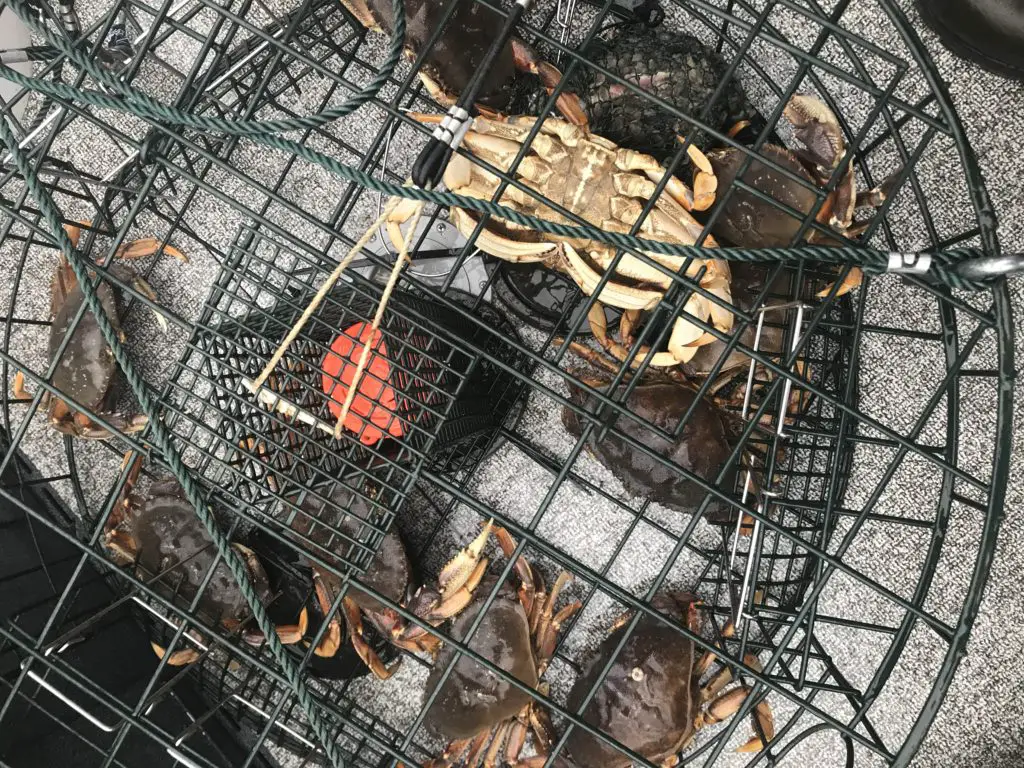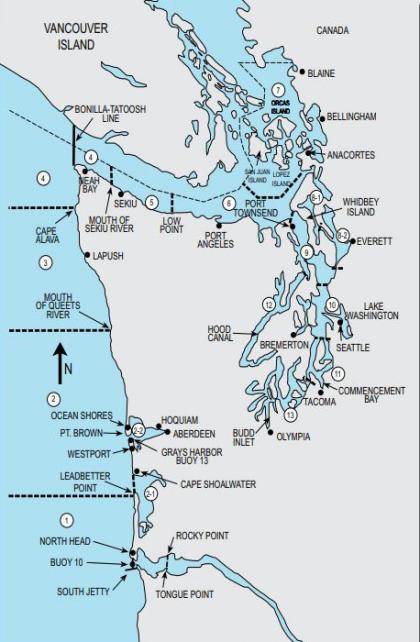
WDFW announced the upcoming 2019 Puget Sound Crab Season on Jun 10th with details on specific dates and locations. Every year this announcement is greatly anticipated as crabbing is one of the most fun harvest activities you can participate in from a dock or from a boat.
Crabbing is also one of my family’s favorite activities. Do you have kids with short attention spans that you want to get on the water doing something YOU love? Crabbing is just perfect for this if you approach it the right way. We will explain how!
Crabbing can also be just that added bonus during salmon season. Coming back in after a few hours of fishing for salmon, and adding a few keeper crab to the haul is just a great way to finish (start?) a day.
But first, let’s get to the WDFW announcement.

The above is a pretty cool depiction of the Marine Areas WDFW has provided to make sure everyone can understand the regulations and how they apply to each location.
Most of the 2019 Puget Sound crabbing seasons in the Strait or interior are going to open on July 4th and go through the usual September 2nd period. This includes Areas 4, 5, 6, 8-1, 8-2, and 9
Area 10 will open on July 4th but end earlier on August 3rd. This is an overlap with the Salmon fishery, so you will get a shot at both on the same days, which is great.
Area 12 will also be open from July 4 – September 2nd, but only north of a projected line east of Ayock Point.
Area 7 gets going a little bit later with the South starting on July 11th, but remaining open until September 30th. North starts even later on August 15th and goes until September 30th.
The bad, but not unexpected news for the 2019 Puget Sound Crab Season, is that Areas 11 and 13 in the South Sound will once again be closed to crabbing. The hope is that these two years of closure will provide a significant recovery that perhaps would allow the season to be open again next year.
The other important note to make is that on every Tuesday and Wednesday everywhere, crabbing will be closed each week throughout the 2019 season.
Update: Winter crab seasons announced!
WDFW has re-opened crabbing throughout most of the northern parts of Puget Sound, Straits, and San Juans. Please consult the official WDFW site for specifics on marine areas and opening/closure dates.
Commercial crabbing in Puget Sound also re-opened on October 1st. I’ve noticed that the recreational crabbing gets a lot better once the commercial season shuts down. Going shallower or much deeper can lead to success when competing with commercials.
I know one angler who was just going to attach his crab pots to his 400 ft shrimp lines this year. I’m hoping to get a day to do this around the Port of Everett to maybe get some Christmas crab added to my scorecard this year.
Here’s a link to our trip in October for winter crab that ended up being quite successful.
More Updates to the Winter Crab Season
Marine Area 8-1 and 8-2, which has the largest biomass of Dungeness crab outside of Marine Area 7, closed down near the end of October but has since re-opened on Thanksgiving day for recreational crabbers to get another shot at it.
I made another crabbing trip out of the Port of Everett in mid-December which you can read about along with the extension of winter crab into 2020.
How to catch crab in Puget Sound
Let’s start with habitat. Dungeness crabs prefer sandy areas whilst Red Rock’s prefer rocky areas. If you aren’t sure which is which, an easy tell, would be to look at the beach nearby where you are crabbing. Generally, a rocky beach will still be rocky in 40 ft of water and the same goes for sand.
You can catch crab in Puget Sound at many different depths, but most success happens in 40-80 ft of water. You will see most pots sitting right at that 40-60 ft line all along the beach.
Just about any pot will work, as long as you fish them the right way. You should always consider adding weight to ensure pots don’t drift off, especially if you are crabbing near channels with stronger currents.
You may also need enough flotation to ensure that even if your pot stays put, you can find it again. I’ve seen my buoy mostly submerged as a result of a strong current and it can be very difficult to find. How many times have you heard the story “Someone stole my pots!”? Not that it doesn’t happen, but more often than not the pot could not be found because of inadequate flotation or weight. WDFW recovers hundreds (thousands?) of derelict pots each season.
You can certainly spend a decent amount on a crab pot, but honestly, it’s just not necessary.
When it comes to bait, there are so many possibilities! In general with bait, you want oils that disperse and draw the crab in. Ever wonder what it looks like underwater as crab are finding their way to your bait?
Most crab are going to enter your trap very soon after being dropped if it has the proper bait that disperses oils/scent quickly.
Salmon carcasses can make a great bait. You can also take unwanted Salmon/Steelhead fillets from those boots you caught last year. It’s great to put whatever bait you have in some kind of “armor” to help it last longer so crabs don’t get disinterested and start searching for a way out of your pot.
And they can exit your pot if determined enough. I like to use my same formula for shrimping bait as a broadcast bait, and then also have something for them to feed on like chicken or salmon in the pot.
If you have leftover razor clam trimmings from earlier this season, you will be crabbing like a pro! No really, it’s what the commercials use and it will drive crab nuts to get into your pots.
Take your (someones?) kids crabbing in 2019
Finally, we need to talk about the take your kids crabbing advice part of this blog post. If your plan is to drop and retrieve the aforementioned larger pots all day with the kiddos on board, there’s a good chance this will not provide sufficient entertainment and you will begin to hear the groans about how long you plan to perform such activities before they can go back in and get back to their favorite video game (booo!)
So here’s the deal: You need a slightly different approach. Get yourself some of these collapsable crab traps by Danielson. Anchor up in a 40-50 ft of water where you want to crab. Bait these with a bit of salmon carcass or even just chicken.
Attach these traps to a fishing rod that you can just set in a rod holder and make it easy for the kids to reel it up. Or you can tie 60 ft of some additional crab line to a cleat for easy handling. Check these traps every 3-5 minutes. If you get enough (3+) of them set, the kids will be busy constantly bringing up and dropping these traps and as long as you keep some of them fishing at all times, you will bring in lots of crab to the area and keep the crab catching going until you and the kids have had your fill of crabbing fun.
Pack some snacks and maybe play some tunes and you have the makings of a crabbing adventure that will make your kids beg you to go back out again!
We plan to publish a more in depth article at some point about Puget Sound Crab, but for now this will have to do. Good luck and get your kids out there enjoying one of the best ways to spend a summer on the Puget Sound.
Loved this article. You covered all the bases, especially the focus on the kids. Thanks!
Thanks!